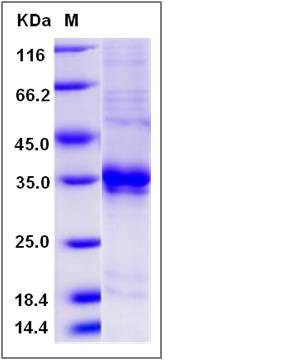Rat ASAM / CLMP Protein (His Tag)
ASAM, Clmp ,Acam
- 100ug (NPP2841) Please inquiry
| Catalog Number | P80219-R08H |
|---|---|
| Organism Species | Rat |
| Host | Human Cells |
| Synonyms | ASAM, Clmp ,Acam |
| Molecular Weight | The recombinant rat ASAM comprises 226 amino acids and predicts a molecular mass of 25.6 kDa. The apparent molecular mass of the recombinant protein is approximately 37 kDa in SDS-PAGE under reducing conditions due to glycosylation. |
| predicted N | Thr 18 |
| SDS-PAGE |  |
| Purity | > 85 % as determined by SDS-PAGE |
| Protein Construction | A DNA sequence encoding the rat ASAM (Q8K1G0) (Met1-Met232) was expressed, fused with a polyhistidine tag at the C-terminus. |
| Bio-activity | |
| Research Area | Neuroscience |Neurology process |Neurodegeneration and Neurodegenerative Disease |Others in Neurodegeneration and Neurodegenerative Disease |
| Formulation | Lyophilized from sterile PBS, pH 7.4 1. Normally 5 % - 8 % trehalose, mannitol and 0.01% Tween80 are added as protectants before lyophilization. Specific concentrations are included in the hardcopy of COA. |
| Background | Adipocyte-specific adhesion molecule (ASAM), also known as ACAM and CLMP, is a type I transmembrane protein and a member of the CTX (cortical thymocyte marker in Xenopus) family within the immunoglobulin superfamily. ASAM protein is highly expressed in the small intestine and placenta, and is found at intermediate levels in the heart, skeletal muscle, colon, spleen, kidney, and lung, and appears in low levels in the liver and peripheral blood leukocytes as well. ASAM is a transmembrane component of tight junctions in epithelial cells that can mediate cell aggregation and regulate transepithelial resistance across polarized epithelial cells. In addition, its expression is strongly correlated with white adipose tissue (WAT) mass of human and rodents with obesity. |
| Reference |
